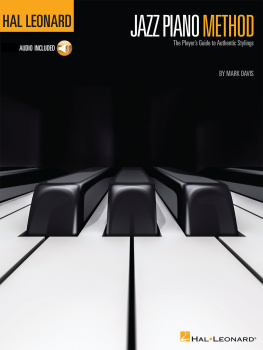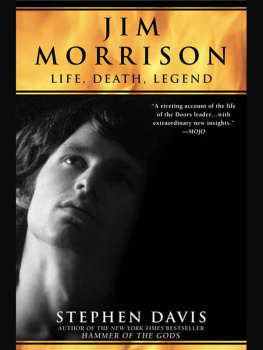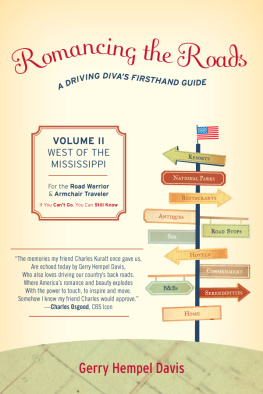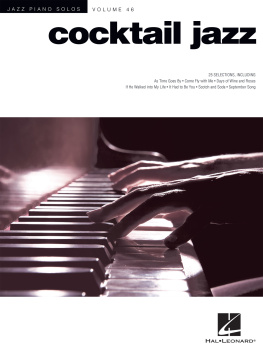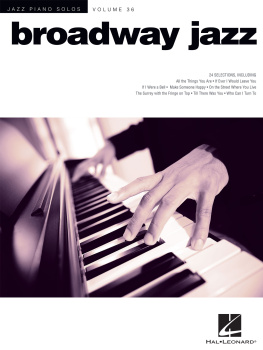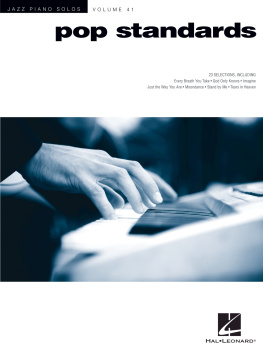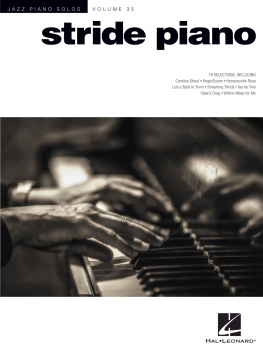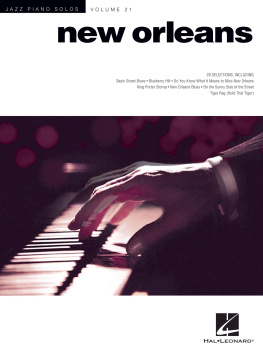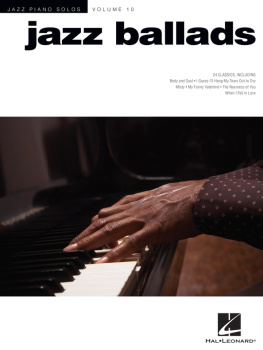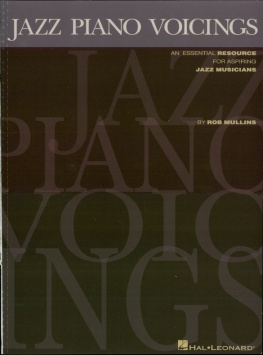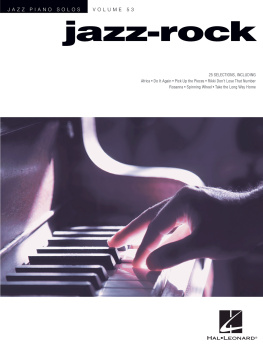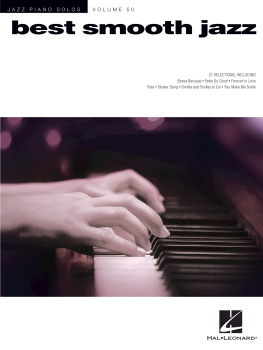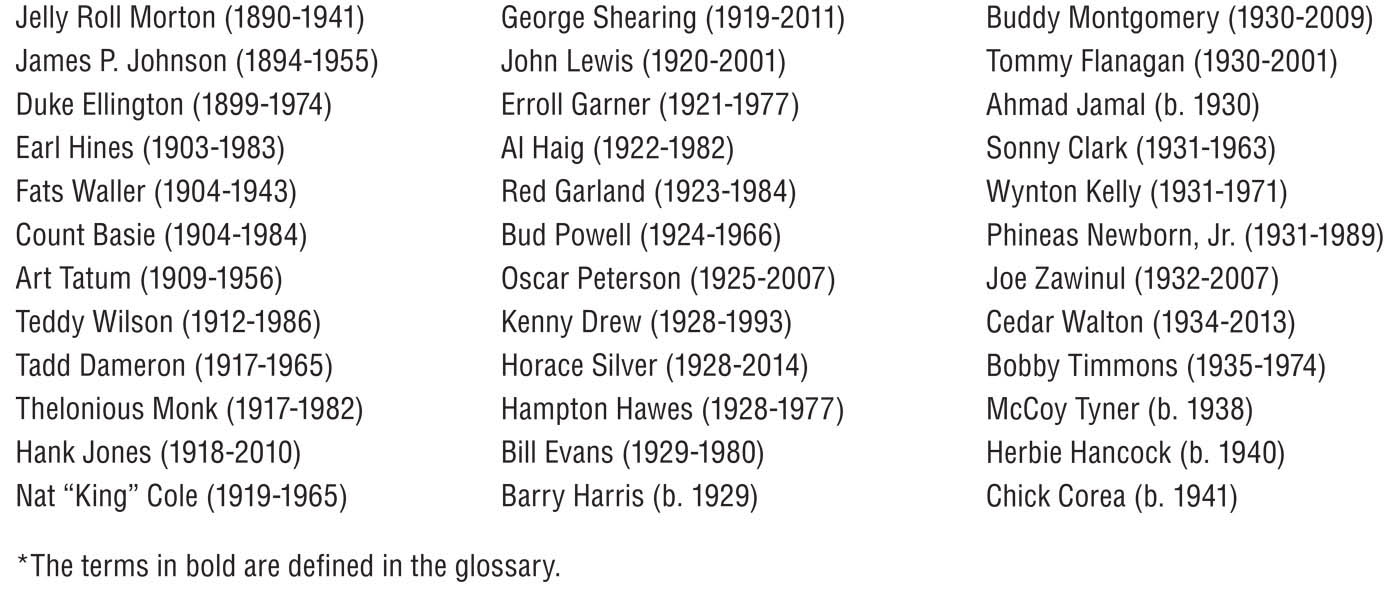7777 W. Bluemound Rd. P.O. Box 13819 Milwaukee, WI 53213
No part of this publication may be reproduced in any form or by any means without the prior written permission of the Publisher.
Contents
CHAPTER 5:
BEGINNING IMPROVISATION
INTRODUCTION
Learning to play jazz can be exciting and fun, but it can also be bewildering and frustrating at times. This method will guide you step by step through the complexities of the music and show you ways to practice that will enable you to play piano in an authentic jazz style. Ultimately, this will allow you to express yourself and find your individual voice. It is important to keep in mind that this is a long road, but one that will yield many rewards along the way.
Only basic piano proficiency and rudimentary music reading are required to begin this study. Following the practice suggestions in this book will help you develop essential jazz techniques that will put you on the road to becoming a skilled jazz pianist. Listening is as important as practicing. Take in live performances and analyze recordings. Go to jam sessions, find others who want to get together and play, and get to know experienced musicians who can answer your questions. I also recommend that you find a good private teacher who can help guide you. Be patient, enjoy the process of learning, and understand that there is no end; there is always more to know, always new things to discover. This is what makes playing jazz piano such a fascinating endeavor.
CHAPTER 1:
GETTING STARTED
Practice Tips
Move through this book in sequence. Take time to master each exercise before moving on. Keep a practice log of your activities and the time you spend on each exercise, technique, or concept. Daily practice is the key to success. Take the time to learn fingerings that will allow you to play fluently. It is also important to practice with a steady pulse. Practice with a metronome and play along with the recorded examples to develop the strong sense of time you will need to play effectively, whether in a group or as a soloist. Always choose a tempo that allows you to play with accuracy. If you are making lots of mistakes because of the tempo, slow it down and then gradually work your way up. Learn to play everything you practice from memory. Resist the urge to play exercises or tunes over and over by reading them. You need to free yourself from the written music in order to become an improviser. As you move through the book, you will undoubtedly need to go back and review certain sections and exercises. This is all part of the process.
Developing Your Ear
Think of a simple melody; it could be Mary Had a Little Lamb or Happy Birthday to You. Randomly pick a starting note on the piano and try your best to play the song. Once you have played it successfully, start on a different note and try to play the song. This is a great way to develop your ear. It also acquaints you with transposition*, the process of moving a group of notes to another key. Its also never too soon to try to play things you hear on recordings, whether its a phrase, an entire melody, or a solo. The act of notating what you hear is called transcribing. Mimicking other players is one of the main ways jazz musicians learn, but it takes practice to get good at it. You may want to try to play some of the recorded examples in this book by ear and then check your accuracy with the notation in the book. Eventually, you will be able to transcribe things you hear on your favorite jazz recordings and this will help your musicianship immensely.
Recommended Listening
In order to play jazz, you need to be listening to it a lot! You must immerse yourself in the music. Listening to all styles of music and to different instrumentalists and vocalists will be a great source of inspiration. The recordings of Louis Armstrong, Charlie Parker, and John Coltrane are essential, and listening to them will give you an excellent historical overview. The following list, however, focuses on some of the historically important jazz pianists and those who are most relevant to the topics in this book. Check out as many of them as you can. For an overview of the history of jazz piano, I suggest you listen to solo recordings by Art Tatum, Bud Powell from 1953 or before (considered by many to be his best period), and McCoy Tyner from the 1960s. Familiarizing yourself with the pianists below will give you a basis for appreciating and assessing the styles of the many incredible pianists who have come to prominence in more recent years.
Styles
As you listen, take note of the various styles you hear. You will begin to recognize certain characteristics that are indicative of the time period in which a recording was made. Early jazz pianists, for example, often played stride with the left hand, a technique that usually involved playing a low note on the first and third beats and a middle register chord on the second and fourth beats of each measure. Pianists of each era used distinctive, identifiable techniques.
You will also hear a variety of rhythmic styles. The basic feel in jazz has been swing, but jazz also makes use of a wide array of grooves that include Latin, rock, and funk. The bossa nova of Brazil has been one of the most prevalent Latin styles that jazz musicians have incorporated. Notice how the music sounds at different tempos, from slow ballads to up-tempo burners. Historically, most jazz has been played in 4/4 time signature, however 3/4, 6/8, and other so-called odd meters such as 5/4 and 7/4 are also used.
Jazz Standards
A jazz standard is a tune that you are expected to know, to have in your repertoire, as a jazz musician. Many of them were composed for musicals or movies and some were written by jazz musicians. Experienced jazz musicians have hundreds of tunes memorized. You should make a point of listening to recordings of standards. Listen to classic versions to learn the basic tune, then listen to many different versions of the same song to understand how different players give it their own unique treatment. If it is a song with lyrics, find a vocal version by someone like Frank Sinatra or Ella Fitzgerald. Knowing the words can help you remember the melody and interpret the song.
Here is a list of some of the most important tunes to know. You may choose to start with the tunes I have marked with a letter B. These tunes are a bit easier for a beginner to learn. Tunes followed by an asterisk are among the most frequently played and, therefore, essential. This list is subjective since the musicians you play with and the musical circles you get into will dictate which tunes are important for you to know. You will likely find there are tunes that are not on this list that will become part of your repertoire.

